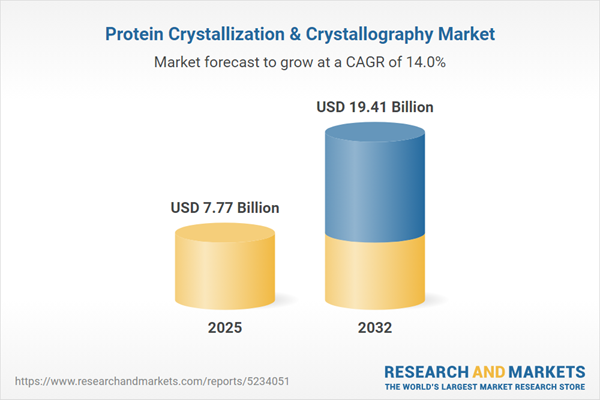Speak directly to the analyst to clarify any post sales queries you may have.
The Protein Crystallization & Crystallography Market is evolving rapidly as structural biology, advanced automation, and artificial intelligence converge to drive new efficiencies and applications across drug development, biotechnology, and fundamental research.
Market Snapshot: Protein Crystallization & Crystallography Market
The Protein Crystallization & Crystallography Market grew from USD 6.80 billion in 2024 to USD 7.77 billion in 2025. It is expected to continue growing at a CAGR of 14.00%, reaching USD 19.41 billion by 2032.
Scope & Segmentation
- Product: Consumables & Reagents (buffers & solutions, crystallization plates, screens & kits), Instruments (crystallization robots, imaging systems, microfluidic platforms, X-ray diffractometers), Software
- Technology: Electron Crystallography, Neutron Crystallography
- Application: Drug Discovery, Materials Science, Structural Biology
- End User: Academic & Research Institutes, Contract Research Organizations, Pharmaceutical & Biotechnology Companies
- Region: Americas (United States, Canada, Mexico, Brazil, Argentina, Chile, Colombia, Peru), Europe, Middle East & Africa (United Kingdom, Germany, France, Russia, Italy, Spain, Netherlands, Sweden, Poland, Switzerland, United Arab Emirates, Saudi Arabia, Qatar, Turkey, Israel, South Africa, Nigeria, Egypt, Kenya), Asia-Pacific (China, India, Japan, Australia, South Korea, Indonesia, Thailand, Malaysia, Singapore, Taiwan)
- Key Companies: Agilent Technologies, Anton Paar, Arinax Scientific Instrumentation, Art Robbins Instruments, Bruker Corporation, Douglas Instruments, Formulatrix, Greiner Bio-One International, Thermo Fisher Scientific, Charles River Laboratories
Key Takeaways for Senior Decision-Makers
- Structural biology is central to drug discovery, enabling precise molecular targeting and improving candidate development pipelines.
- Adoption of automation, microfluidics, and AI streamlines experimental workflows, enhancing throughput and data quality for both industry and academia.
- Integrating crystallography data with computational modeling supports in silico screening and virtual docking, accelerating the design of new therapeutics.
- Cross-technology integration, including cryo-electron microscopy and NMR, provides in-depth insight into dynamic protein conformations and regulatory mechanisms.
- Strong regional investment and collaboration empower emerging markets, while established hubs focus on expanding high-throughput and advanced capabilities.
- Sustainability and supply chain diversification are gaining importance as industry priorities, aligning structural biology with broader corporate initiatives.
Assessing 2025 Tariff Impact on Industry Dynamics
Recent United States tariffs have directly affected supply chains for protein crystallization, increasing prices for consumables and instruments. Laboratories are adjusting vendor strategies, sourcing solutions locally, and adopting cost-saving experimental formats. While tariffs present challenges, they are also driving the sector toward innovation in resource use, workflow efficiency, and supply diversification.
Methodology & Data Sources
This report utilizes a multi-stage research methodology, combining rigorous secondary research with in-depth primary interviews across stakeholder groups. Insights are triangulated from scientific literature, corporate data, patent filings, and subject matter expertise. Quality control measures ensure results are validated, comprehensive, and reliable.
Why This Report Matters
- Enables executives to benchmark market positioning, evaluate technology adoption, and anticipate regulatory or supply chain risks.
- Supports strategic decisions with reliable segmentation data, actionable insights, and detailed analysis of competitive dynamics.
- Drives innovation strategy by highlighting key technology trends and their impact on growth opportunities across global markets.
Conclusion
As the protein crystallization and crystallography landscape evolves, industry leaders must align technical capabilities with agile business strategies. This report equips decision-makers to capitalize on emerging trends, strengthen partnerships, and build long-term market resilience.
Additional Product Information:
- Purchase of this report includes 1 year online access with quarterly updates.
- This report can be updated on request. Please contact our Customer Experience team using the Ask a Question widget on our website.
Table of Contents
3. Executive Summary
4. Market Overview
7. Cumulative Impact of Artificial Intelligence 2025
Companies Mentioned
The companies profiled in this Protein Crystallization & Crystallography market report include:- Agilent Technologies, Inc.
- Anton Paar GmbH
- Arinax Scientific Instrumentation
- Art Robbins Instruments
- Bruker Corporation
- Douglas Instruments Limited
- Formulatrix, Inc.
- Greiner Bio-One International GmbH
- Thermo Fisher Scientific Inc.
- Charles River Laboratories, Inc.
Table Information
| Report Attribute | Details |
|---|---|
| No. of Pages | 194 |
| Published | November 2025 |
| Forecast Period | 2025 - 2032 |
| Estimated Market Value ( USD | $ 7.77 Billion |
| Forecasted Market Value ( USD | $ 19.41 Billion |
| Compound Annual Growth Rate | 14.0% |
| Regions Covered | Global |
| No. of Companies Mentioned | 11 |









